Frequently Asked Questions about Insects
A place for the curious to help them track down and get information about insects they may encounter here in California and elsewhere. If any of these links don't work, let me know and I'll look into it.
Note that all images are property of the owners of the web pages on which they appear, unless otherwise noted, and cannot be reproduced without permission.
Brown Recluse Spider Bite Info
Africanized Honey Bee in California Info
JERUSALEM CRICKETS - Family STENOPELMATIDAE
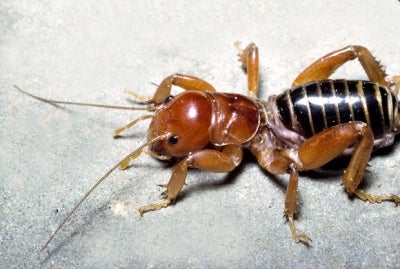
Also known as "Potato Bug" (not to be confused with pillbugs, also sometimes called this), "Child of the Earth", "Niño de la Tierra" or "Woh-tzi-Neh" (Old Bald-headed Man), these large, flightless crickets are a constant source of fear and amazement to Californians, and one of THE most common sources of insect-related questions on the internet. They are, contrary to popular misconception, harmless and not venomous, though they are large enough and strong enough to inflict a painful bite, or jab with their leg spines, if handled carelessly. So far as is known, they feed on vegetable material, and are primarily nocturnal, hiding during the day. Most species seem to thrive only in areas of sandy soil, and a number of species are extremely rare, limited to a single small dune system, and thereby potentially on the brink of extinction; accordingly, it is suggested that you do not kill them if you encounter them.
HOUSE CENTIPEDE - Family SCUTIGERIDAE
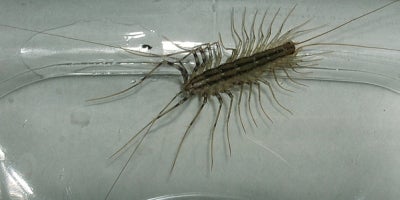
These fast-moving predators (Scutigera coleoptrata) are, in fact, the indoor equivalents of the Praying Mantis - that is, they eat all sorts of household pests, and are therefore very beneficial to have around, and they should not be killed. When you consider that each centipede must kill several roaches, houseflies, carpet beetles, and other such pests, you can realize that for every centipede one squishes, there are that many more pests that are left unmolested to torment the homeowner. So, if there's anything to ponder when one encounters a house centipede, the only real worry should be "What is it eating?"
Links:
Notes on centipedes
SOLPUGIDS - Families EREMOBATIDAE and AMMOTRECHIDAE
Solpugids, also known as Solifugids, "Sun Scorpions", "Camel Spiders", "Sun Spiders", "Wind Scorpions", and other similar names, are a type of nocturnal arachnid (not insects at all) somewhat related to scorpions, but representing a distinct evolutionary lineage. They are especially common in desert regions of the world, including Southern California, where various species in genera such as Eremobates and Ammotrecha regularly surprise and bewilder people encountering them for the first time. With their huge jaws (chelicerae), they are fearsome in appearance [see images below], but have no venom, and if they bite humans (requiring provocation) nothing will happen (despite some rather wild urban legends told by Desert Storm veterans). They are voracious predators of small arthropods, however, using the force of their jaws to kill their prey rather than venom. Some stories of them clipping hairs off the faces of sleeping humans do seem to have credible sources, but the only speculation as to why they might do this is if females use the hairs as lining for the burrow where they lay their eggs (a big IF). Since they are harmless to humans and many of the arthropods they consume are pests, Solpugids can be considered beneficial, and should be left unmolested.
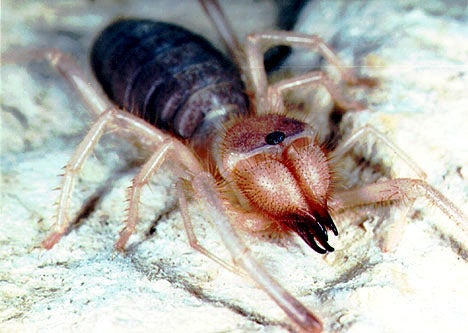
|
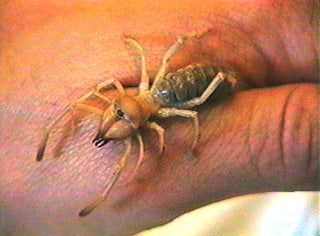
|
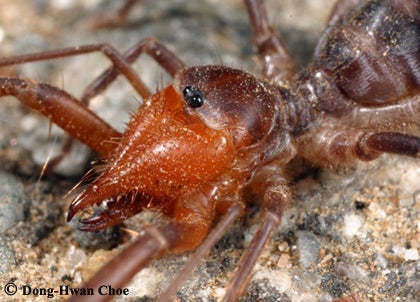
|
Links:
color photo, general info
BOXELDER BUGS - Family RHOPALIDAE
These insects, Boisea trivittata (and the western B. rubrolineata) are among the most infamous "nuisance" pests, in that they are completely harmless, but occur in such huge numbers that they will cover the sides of people's houses and get indoors by the hundreds. This sort of mass insect visitation often leads to panic and fear. Unfortunately, most homeowners are not reassured when told these bugs are harmless, and still go ahead and spray, which probably does more harm than good. If this is a recurring problem, then the simplest solution - and the only long-term solution - is to remove the boxelder tree (or trees) on which the bugs are feeding. The problem is that often there are many trees, not all of which are on the afflicted homeowner's property, and that these bugs will also sometimes feed on other maple species (yes, "boxelder" is a maple); in other words, removing the trees works only if ALL the possible host trees around are removed, and that's often impossible to coordinate when several pieces of property are involved.
ASIAN LADYBUG - Family COCCINELLIDAE
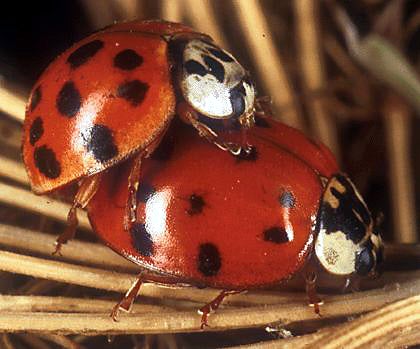
The "Asian Ladybug" (or, more precisely, Asian Lady Beetle), Harmonia axyridis is almost as bad a nuisance pest as the Boxelder Bug, in that they also swamp people's houses in the fall, especially October, getting indoors by the hundreds. Most homeowners at least can recognize ALBs as ladybugs, even though their coloration is variable [see image below, courtesy of Rob Curtis/The Early Birder] and they know not to be afraid of them (ironic, since these, like many ladybugs, WILL occasionally bite people), but the concern about hundreds of insects in one's home is still real. This insect was introduced to the US intentionally by the USDA (ostensibly to help increase the level of biological aphid control, especially of the Hemlock Woolly Adelgid - native ladybugs have their own natural enemies, you see, but the ALB, being exotic, has no natural enemies here), but apparently became established accidentally in the early '90s, though this is still unclear. It worked better than anyone had expected, and the ALB populations now reach epidemic proportions. The feds apparently had no idea that the ALB was also fond of warm places to spend the winter in hibernation, so imagine everyone's surprise when millions of complaints started pouring in from people who found these beetles invading their homes in the fall, starting in about 1993.
To make the long story short, we're all going to have to get used to this, because there's no stopping them now. The ALB is here to stay, for our lifetimes, at least. Ecologically speaking, there is no reason not to kill them if they are in your home, since even if you could kill 50,000 of them, it wouldn't make a dent in their numbers; there are literally BILLIONS of them that will pass the winter across the US any given year. Moreover, they're an exotic species, and they're apparently driving our native ladybugs to extinction. Yes, really. If you want to toss them outside for the winter, then go right ahead - but there are no repellents to keep them away, so until the weather turns too cold for them to keep flying, you'll probably have more sneaking into your house. Note that ALBs, like all ladybugs, secrete a yellow, odorous defensive fluid, so if you squish them, you'll get yellow stains on whatever you squish them with. Some people have taken to just vacuuming them up and tossing them.
CARPENTER BEES - Family APIDAE
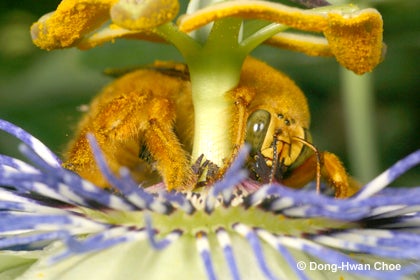
These large bees have a tendency to scare the bejeezus out of people because of their large size and the territorial behavior of the males (which do not sting), such as swooping down towards people from up near their eaves. In the northeastern US, and most of the country, the only species is Xylocopa virginica (not "virginiana"), while in California, the three common species are X. varipuncta, X. tabaniformis, and X. californica. The first species looks like a bumblebee, with yellow thorax and black abdomen (but the abdomen is SHINY, unlike all bumblebees), and males have yellow faces; the second has all-black females with bluish wings (that have greenish-gold reflections), but the males are golden-brown; the third has smaller black females, and the males are grayish with light faces; the last resembles the first somewhat, though the females have darker hair on the thorax and the abdomen has definite blue or blue-green metallic tints to it. Generally speaking, the damage they do is only cosmetic, and it is very rare for them to do enough damage to wood to cause structural problems. It is also uncommon for them to dig their tunnels into any wood that has a thick layer of paint or varnish on it, so this can be used as a fairly effective preventative measure.
Links:
VELVET ANTS - Family MUTILLIDAE
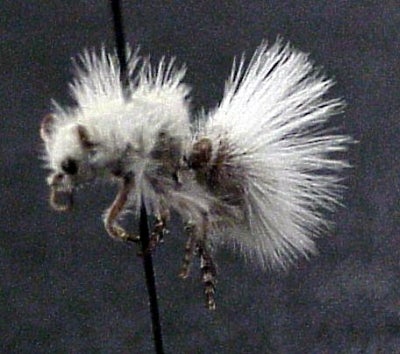
People are ALWAYS asking about these wasps, especially the species known as "The Cow-Killer", Dasymutilla occidentalis. This wasp lays its eggs in the nests of the "Cicada-Killer" wasp, Sphecius speciosus (see below), where its larva will eventually eat the cicada-killer larva. If you've got one of these wasps around, odds are good you'll see the other one nearby. There are over 450 other species in North America, nearly all of them laying their eggs in the nests of ground-nesting bees and wasps, especially in the Southwestern deserts. Most species are red and black, orange and black, or white and black [see here for a SW species, Dasymutilla gloriosa that mimics creosote bush seeds]; for most species this is warning coloration (called "aposematism"), associated with the fact that females (which are always wingless) pack a VERY potent and painful sting. Some people consider it the MOST painful venom (see here), but this is always subjective. The males all have wings, and do NOT sting, as is true of almost all male wasps.
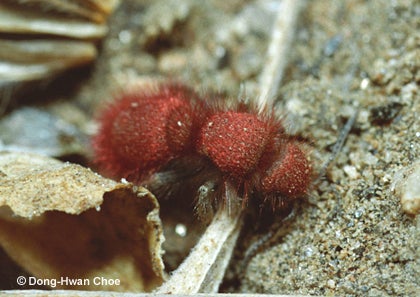
Links:
General notes on various wasps and bees, photos
Dasymutilla sp. color photo, courtesy of Rob Curtis/The Early Birder
TARANTULA HAWK WASPS - Family POMPILIDAE
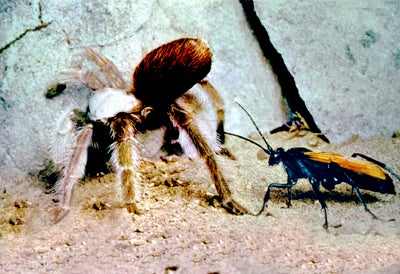
This group of wasps includes some of the largest stinging insects in the world, and reportedly some of the most painful to be stung by, mostly due to the size of the sting itself and the volume of venom injected. Normally, use of this sting is reserved for their prey, which the venom paralyzes, but if mishandled by a person, they will use it in self-defense. They can be found essentially anywhere tarantulas and trap-door spiders occur, with the greatest abundance in the desert Southwest. Most SW species are black with metallic bluish highlights and orange wings, but species with black wings occur. There are two genera, Pepsis and Hemipepsis, which are very difficult to separate (subtle features of wing venation), but almost identical in biology. These wasps commonly visit flowers, especially milkweeds, for nectar, as this is essentially all the adult wasps feed on. The males are generally more often encountered than females, and can be recognized by their longer, straighter antennae, while females have short and rather strongly curled antennae.
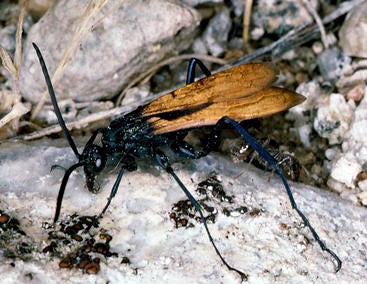
Links:
Pepsis sp. photo, information
CICADA KILLERS - Family NYSSONIDAE
Found throughout much of North America, the wasp Sphecius speciosus hunts cicadas (usually in the genus Tibicen), and stings them to paralyze them, burying them alive as food for the wasp larvae. Females may have multiple underground chambers, one larva in each, in a single nest. Male cicada killers are strongly territorial, and will patrol almost incessantly in a small area near a nest aggregation, flying at anything passing by. They will even fly at humans, but are harmless unless they are grabbed. Male cicada killers are one of the very few cases where a male wasp can inflict a painful sting, using a sharp, venomless spine (called a pseudosting) at the tip of its abdomen. In the southwestern US there are two different species in the same genus, S. convallis and S. grandis, whose appearance and biology is very similar, though they apparently prey on different types of cicadas, such as Diceroprocta.
Links:
Wikipedia
EUROPEAN HORNET - Family VESPIDAE
An introduced species now found over much of North America, the European Hornet, Vespa crabro, is the largest social wasp in North America, and very distinctively colored (see here, courtesy of Rob Curtis/The Early Birder). They are fairly aggressive, and if the nests are disturbed you can expect to be stung, but fortunately the colonies have many fewer workers (less than 500) than colonies of yellowjackets (often in the thousands), so one does not generally get stung as many times. Nests are generally built in somewhat concealed locations, in tree hollows or structural cavities, and are therefore not as easy to blunder into accidentally as YJ nests, but harder to remove when found. They are predators on various sorts of insects, and one of the few wasps that can be found flying at night.
Links:
Vespa crabro color photos, other info
EUROPEAN PAPER WASP - Family VESPIDAE
Another introduced species now found throughout eastern North America, and spreading farther west all the time, the European Paper Wasp, Polistes dominulus, is more strongly patterned black and yellow than any of the paper wasp species native to North America, (see here, courtesy of Rob Curtis/The Early Birder), and is commonly mistaken for a yellowjacket species, but easily recognizable by its much more slender body and longer legs, as well as its nest structure. Unlike hornets and yellowjackets, paper wasps have exposed, single nest combs in which all of the brood are raised. Nests are commonly built under eaves, and the wasps rarely re-use the same nest between years. Like most paper wasps they are only marginally aggressive, and one has to get rather close to a nest in order to provoke an attack. There are very few wasps per colony, in most areas of the country, rarely exceeding 50 adults at any given time. They are predators on various sorts of insects (as are yellowjackets and hornets), many of them garden or tree pests.
Links:
fact sheet
REDGUM LERP PSYLLID - Family PSYLLIDAE
The Redgum Lerp Psyllid, Glycaspis brimblecombei, is a recently-established and serious pest of several species of Eucalyptus planted in California. There is still much that needs to be done before there are established control policies, but a number of the links below offer recommendations. I'll note that the sugary lerps (see here) produced by these insects are edible, if a little difficult to harvest.
Links:
bugguide.net
MEGARHYSSA WASPS - Family ICHNEUMONIDAE
Megarhyssa are a type of parasitic Ichneumonid wasp which lay eggs in the larvae of horntail wasps (Family Siricidae; the larvae are wood-boring) inside tree trunks. These are the largest of the Ichneumons, with some species having bodies around 2 inches long, and an ovipositor as much as 4 inches long. Surprisingly (to many people), they cannot sting, but that enormous flexible ovipositor can be drilled deep into trees, to deposit the egg in the body of the host larva. They're not too commonly seen, but few people forget seeing one.
Links:
Wikipedia
HORNTAIL WASPS - Family SIRICIDAE
As mentioned above, the larvae of horntail wasps live inside tree trunks. The adult wasps are large, striking, and impressive [see here, and here, courtesy of Rob Curtis/The Early Birder], but they cannot sting with their ovipositor. One thing the females do inject with the egg is some symbiotic fungus, essential for the survival of the larvae, since they apparently do not digest the wood themselves.
MUD DAUBERS - Families CRABRONIDAE and SPHECIDAE
There are several wasps in different families and genera which are called "mud daubers": the three genera are Trypoxylon (Crabronidae), Sceliphron (Sphecidae), and Chalybion (Sphecidae). Of these, only the first is even slightly aggressive, and generally must be grabbed in order to be provoked into stinging. All three types provision their nests with paralyzed spiders as food for the wasp larvae. However, only Trypoxylon and Sceliphron actually construct their own nests; the former make long parallel mud tubes resembling "organ pipes", and the latter make thick, elongated egg-like chambers. Chalybion californicum uses old nests of Sceliphron instead of constructing its own nests, and one of the common spider prey items for this wasp is the Black Widow spider (Latrodectes mactans).
HUMMINGBIRD SPHINX MOTHS - Family SPHINGIDAE
Sphinx moths in the genus Hemaris are typically called hummingbird moths because they resemble hummingbirds in flight, though in reality they are bumblebee mimics (a predator who has tried to eat a bumblebee and been stung is unlikely to attempt to eat one of these moths, even though they are completely harmless). Evidence for true mimicry is that the moths vary in color pattern geographically to precisely match the local bumblebee species. They hover at flowers while taking nectar, however, while bumblebees have to land to feed. These moths may act as pollinators, and at least one native orchid, Platanthera lacera, relies on them for pollination. Hemaris diffinis [see here] is probably the most common of the three North American species in this genus, called the Bumblebee Sphinx Moth or Snowberry Clearwing (because the caterpillar, a hornworm, sometimes feeds on snowberry, though it also feeds on honeysuckle). Hemaris thysbe [see here] is known as the Hummingbird Sphinx Moth or Common Clearwing, and its larvae feed on hawthorn, honeysuckle, and other plants. Hemaris gracilis larvae feed only on blueberries, and this species is the rarest of the three; it is on some State Lists of threatened species.
TOMATO HORNWORM - Family SPHINGIDAE
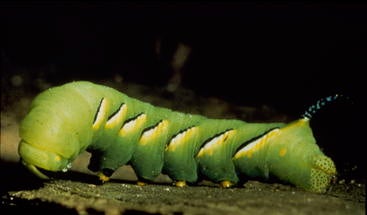
The Tomato Hornworm is the larva of one of two large sphinx moths, Manduca sexta (the "Tobacco Hornworm"), or Manduca quinquemaculata (the "Tomato Hornworm"). Both species will feed on tomato, though M. sexta tends to be the more commonly encountered of the two species (despite it being called the "Tobacco Hornworm"). The larvae grow to be quite large, and feed on a variety of plants in the tomato family (including tobacco, potato), and most gardeners raising tomatoes encounter them eventually. It is common to see numerous small silk cocoons (NOT the eggs, which are laid internally) of parasitic Cotesia Braconid wasps on the bodies of hornworms, a sign of the imminent death of the caterpillar. Biological control at its best.
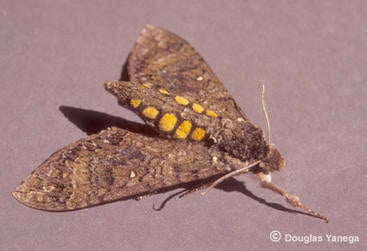
Links:
Manduca spp. photos, info
SADDLEBACK CATERPILLAR - Family LIMACODIDAE
The Saddleback Caterpillar is the slug-like larva of the moth Acharia (=Sibine) stimulea, a common North American representative of a large family of tropical moths. The larvae have stinging hairs which can raise serious welts. Note that this is one of a VERY small number of larvae in North America which are venomous (another is listed below), and none of these are life-threatening (except for very rare cases of hyper-allergic responses, which can happen with almost ANY chemical, natural or man-made).
Links:
Acharia stimulea larva, drawing
various venomous caterpillars
IO MOTH - Family SATURNIIDAE
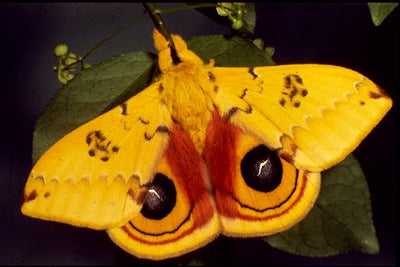
The Io Moth, Automeris io, is the most common North American representative of a large genus of primarily neotropical moths. The larvae have stinging hairs, and feed on a variety of plants, so are somewhat commonly encountered, and often on less-than-friendly terms.
Links:
Automeris io larva, drawing
various venomous caterpillars
Translation of this page in Belorussian

